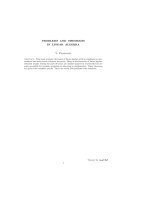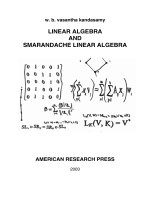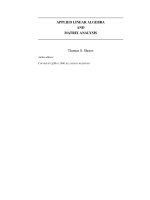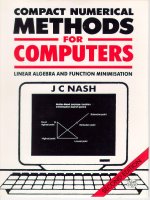Elementary linear algebra anton rorres 10th edition
Bạn đang xem bản rút gọn của tài liệu. Xem và tải ngay bản đầy đủ của tài liệu tại đây (33.53 MB, 1,277 trang )
www.elsolucionario.org
About The Author
Howard Anton obtained his B.A. from Lehigh University, his M.A. from the University of Illinois, and his
Ph.D. from the Polytechnic University of Brooklyn, all in mathematics. In the early 1960s he worked for
Burroughs Corporation and Avco Corporation at Cape Canaveral, Florida, where he was involved with the
manned space program. In 1968 he joined the Mathematics Department at Drexel University, where he taught
full time until 1983. Since then he has devoted the majority of his time to textbook writing and activities for
mathematical associations. Dr. Anton was president of the EPADEL Section of the Mathematical Association
of America (MAA), served on the Board of Governors of that organization, and guided the creation of the
Student Chapters of the MAA. In addition to various pedagogical articles, he has published numerous
research papers in functional analysis, approximation theory, and topology. He is best known for his textbooks
in mathematics, which are among the most widely used in the world. There are currently more than 150
versions of his books, including translations into Spanish, Arabic, Portuguese, Italian, Indonesian, French,
Japanese, Chinese, Hebrew, and German. For relaxation, Dr. Anton enjoys travel and photography.
Copyright © 2010 John Wiley & Sons, Inc. All rights reserved.
Preface
This edition of Elementary Linear Algebra gives an introductory treatment of linear algebra that is suitable for
a first undergraduate course. Its aim is to present the fundamentals of linear algebra in the clearest possible
way—sound pedagogy is the main consideration. Although calculus is not a prerequisite, there is some
optional material that is clearly marked for students with a calculus background. If desired, that material can
be omitted without loss of continuity.
Technology is not required to use this text, but for instructors who would like to use MATLAB, Mathematica,
Maple, or calculators with linear algebra capabilities, we have posted some supporting material that can be
accessed at either of the following Web sites:
www.howardanton.com
www.wiley.com/college/anton
Summary of Changes in this Edition
This edition is a major revision of its predecessor. In addition to including some new material, some of the old
material has been streamlined to ensure that the major topics can all be covered in a standard course. These
are the most significant changes:
• Vectors in 2-space, 3-space, and n-space Chapters 3 and 4 of the previous edition have been combined
into a single chapter. This has enabled us to eliminate some duplicate exposition and to juxtapose concepts
in n-space with those in 2-space and 3-space, thereby conveying more clearly how n-space ideas generalize
those already familiar to the student.
• New Pedagogical Elements Each section now ends with a Concept Review and a Skills mastery that
provide the student a convenient reference to the main ideas in that section.
• New Exercises Many new exercises have been added, including a set of True/False exercises at the end of
most sections.
• Earlier Coverage of Eigenvalues and Eigenvectors The chapter on eigenvalues and eigenvectors, which
was Chapter 7 in the previous edition, is Chapter 5 in this edition.
• Complex Vector Spaces The chapter entitled Complex Vector Spaces in the previous edition has been
completely revised. The most important ideas are now covered in Section 5.3 and Section 7.5 in the context
of matrix diagonalization. A brief review of complex numbers is included in the Appendix.
• Quadratic Forms This material has been extensively rewritten to focus more precisely on the most
important ideas.
• New Chapter on Numerical Methods In the previous edition an assortment of topics appeared in the last
chapter. That chapter has been replaced by a new chapter that focuses exclusively on numerical methods of
linear algebra. We achieved this by moving those topics not concerned with numerical methods elsewhere
in the text.
• Singular-Value Decomposition In recognition of its growing importance, a new section on Singular-Value
Decomposition has been added to the chapter on numerical methods.
www.elsolucionario.org
• Internet Search and the Power Method A new section on the Power Method and its application to
Internet search engines has been added to the chapter on numerical methods.
• Applications There is an expanded version of this text by Howard Anton and Chris Rorres entitled
Elementary Linear Algebra: Applications Version, 10th (ISBN 9780470432051), whose purpose is to
supplement this version with an extensive body of applications. However, to accommodate instructors who
asked us to include some applications in this version of the text, we have done so. These are generally less
detailed than those appearing in the Anton/Rorres text and can be omitted without loss of continuity.
Hallmark Features
• Relationships Among Concepts One of our main pedagogical goals is to convey to the student that linear
algebra is a cohesive subject and not simply a collection of isolated definitions and techniques. One way in
which we do this is by using a crescendo of Equivalent Statements theorems that continually revisit
relationships among systems of equations, matrices, determinants, vectors, linear transformations, and
eigenvalues. To get a general sense of how we use this technique see Theorems 1.5.3, 1.6.4, 2.3.8, 4.8.10,
4.10.4 and then Theorem 5.1.6, for example.
• Smooth Transition to Abstraction Because the transition from Rn to general vector spaces is difficult for
many students, considerable effort is devoted to explaining the purpose of abstraction and helping the
student to “visualize” abstract ideas by drawing analogies to familiar geometric ideas.
• Mathematical Precision When reasonable, we try to be mathematically precise. In keeping with the level
of student audience, proofs are presented in a patient style that is tailored for beginners. There is a brief
section in the Appendix on how to read proof statements, and there are various exercises in which students
are guided through the steps of a proof and asked for justification.
• Suitability for a Diverse Audience This text is designed to serve the needs of students in engineering,
computer science, biology, physics, business, and economics as well as those majoring in mathematics.
• Historical Notes To give the students a sense of mathematical history and to convey that real people
created the mathematical theorems and equations they are studying, we have included numerous Historical
Notes that put the topic being studied in historical perspective.
About the Exercises
• Graded Exercise Sets Each exercise set begins with routine drill problems and progresses to problems
with more substance.
• True/False Exercises Most exercise sets end with a set of True/False exercises that are designed to check
conceptual understanding and logical reasoning. To avoid pure guessing, the students are required to justify
their responses in some way.
• Supplementary Exercise Sets Most chapters end with a set of supplementary exercises that tend to be
more challenging and force the student to draw on ideas from the entire chapter rather than a specific
section.
Supplementary Materials for Students
• Student Solutions Manual This supplement provides detailed solutions to most theoretical exercises and
to at least one nonroutine exercise of every type (ISBN 9780470458228).
• Technology Exercises and Data Files The technology exercises that appeared in the previous edition have
been moved to the Web site that accompanies this text. Those exercises are designed to be solved using
MATLAB, Mathematica, or Maple and are accompanied by data files in all three formats. The exercises and
data can be downloaded from either of the following Web sites.
www.howardanton.com
www.wiley.com/college/anton
Supplementary Materials for Instructors
• Instructor's Solutions Manual This supplement provides worked-out solutions to most exercises in the
text (ISBN 9780470458235).
• WileyPLUS™ This is Wiley's proprietary online teaching and learning environment that integrates a
digital version of this textbook with instructor and student resources to fit a variety of teaching and learning
styles. WileyPLUS will help your students master concepts in a rich and structured environment that is
available to them 24/7. It will also help you to personalize and manage your course more effectively with
student assessments, assignments, grade tracking, and other useful tools.
• Your students will receive timely access to resources that address their individual needs and will
receive immediate feedback and remediation resources when needed.
• There are also self-assessment tools that are linked to the relevant portions of the text that will enable
your students to take control of their own learning and practice.
• WileyPLUS will help you to identify those students who are falling behind and to intervene in a
timely manner without waiting for scheduled office hours.
More information about WileyPLUS can be obtained from your Wiley representative.
A Guide for the Instructor
Although linear algebra courses vary widely in content and philosophy, most courses fall into two categories
—those with about 35–40 lectures and those with about 25–30 lectures. Accordingly, we have created long
and short templates as possible starting points for constructing a course outline. Of course, these are just
guides, and you will certainly want to customize them to fit your local interests and requirements. Neither of
these sample templates includes applications. Those can be added, if desired, as time permits.
Long Template Short Template
Chapter 1: Systems of Linear Equations and Matrices
7 lectures
6 lectures
Chapter 2: Determinants
3 lectures
2 lectures
Long Template Short Template
Chapter 3: Euclidean Vector Spaces
4 lectures
3 lectures
Chapter 4: General Vector Spaces
10 lectures
10 lectures
Chapter 5: Eigenvalues and Eigenvectors
3 lectures
3 lectures
Chapter 6: Inner Product Spaces
3 lectures
1 lecture
Chapter 7: Diagonalization and Quadratic Forms
4 lectures
3 lectures
Chapter 8: Linear Transformations
3 lectures
2 lectures
37 lectures
30 lectures
Total:
Acknowledgements
I would like to express my appreciation to the following people whose helpful guidance has greatly improved
the text.
Reviewers and Contributors
Don Allen, Texas A&M University
John Alongi, Northwestern University
John Beachy, Northern Illinois University
Przemslaw Bogacki, Old Dominion University
Robert Buchanan, Millersville University of Pennsylvania
Ralph Byers, University of Kansas
Evangelos A. Coutsias, University of New Mexico
Joshua Du, Kennesaw State University
Fatemeh Emdad, Michigan Technological University
Vincent Ervin, Clemson University
Anda Gadidov, Kennesaw State University
Guillermo Goldsztein, Georgia Institute of Technology
Tracy Hamilton, California State University, Sacramento
Amanda Hattway, Wentworth Institute of Technology
Heather Hulett, University of Wisconsin—La Crosse
David Hyeon, Northern Illinois University
Matt Insall, Missouri University of Science and Technology
Mic Jackson, Earlham College
Anton Kaul, California Polytechnic Institute, San Luis Obispo
www.elsolucionario.org
Harihar Khanal, Embry-Riddle University
Hendrik Kuiper, Arizona State University
Kouok Law, Georgia Perimeter College
James McKinney, California State University, Pomona
Eric Schmutz, Drexel University
Qin Sheng, Baylor University
Adam Sikora, State University of New York at Buffalo
Allan Silberger, Cleveland State University
Dana Williams, Dartmouth College
Mathematical Advisors
Special thanks are due to a number of talented teachers and mathematicians who provided pedagogical
guidance, provided help with answers and exercises, or provided detailed checking or proofreading:
John Alongi, Northwestern University
Scott Annin, California State University, Fullerton
Anton Kaul, California Polytechnic State University
Sarah Streett
Cindy Trimble, C Trimble and Associates
Brad Davis, C Trimble and Associates
The Wiley Support Team
David Dietz, Senior Acquisitions Editor
Jeff Benson, Assistant Editor
Pamela Lashbrook, Senior Editorial Assistant
Janet Foxman, Production Editor
Maddy Lesure, Senior Designer
Laurie Rosatone, Vice President and Publisher
Sarah Davis, Senior Marketing Manager
Diana Smith, Marketing Assistant
Melissa Edwards, Media Editor
Lisa Sabatini, Media Project Manager
Sheena Goldstein, Photo Editor
Carol Sawyer, Production Manager
Lilian Brady, Copyeditor
Special Contributions
The talents and dedication of many individuals are required to produce a book such as this, and I am fortunate
to have benefited from the expertise of the following people:
David Dietz — my editor, for his attention to detail, his sound judgment, and his unwavering faith in me.
Jeff Benson — my assistant editor, who did an unbelievable job in organizing and coordinating the many
threads required to make this edition a reality.
Carol Sawyer — of The Perfect Proof, who coordinated the myriad of details in the production process. It
will be a pleasure to finally delete from my computer the hundreds of emails we exchanged in the course of
working together on this book.
Scott Annin — California State University at Fullerton, who critiqued the previous edition and provided
valuable ideas on how to improve the text. I feel fortunate to have had the benefit of Prof. Annin's teaching
expertise and insights.
Dan Kirschenbaum — of The Art of Arlene and Dan Kirschenbaum, whose artistic and technical expertise
resolved some difficult and critical illustration issues.
Bill Tuohy — who read parts of the manuscript and whose critical eye for detail had an important influence
on the evolution of the text.
Pat Anton — who proofread manuscript, when needed, and shouldered the burden of household chores to
free up time for me to work on this edition.
Maddy Lesure — our text and cover designer whose unerring sense of elegant design is apparent in the
pages of this book.
Rena Lam — of Techsetters, Inc., who did an absolutely amazing job of wading through a nightmare of
author edits, scribbles, and last-minute changes to produce a beautiful book.
John Rogosich — of Techsetters, Inc., who skillfully programmed the design elements of the book and
resolved numerous thorny typesetting issues.
Lilian Brady — my copyeditor of many years, whose eye for typography and whose knowledge of language
never ceases to amaze me.
The Wiley Team — There are many other people at Wiley who worked behind the scenes and to whom I owe
a debt of gratitude: Laurie Rosatone, Ann Berlin, Dorothy Sinclair, Janet Foxman, Sarah Davis, Harry Nolan,
Sheena Goldstein, Melissa Edwards, and Norm Christiansen. Thanks to you all.
Copyright © 2010 John Wiley & Sons, Inc. All rights reserved.
CHAPTER
1
Systems of Linear
Equations and Matrices
CHAPTER CONTENTS
1.1. Introduction to Systems of Linear Equations
1.2. Gaussian Elimination
1.3. Matrices and Matrix Operations
1.4. Inverses; Algebraic Properties of Matrices
1.5. Elementary Matrices and a Method for Finding
1.6. More on Linear Systems and Invertible Matrices
1.7. Diagonal, Triangular, and Symmetric Matrices
1.8. Applications of Linear Systems
• Network Analysis (Traffic Flow)
• Electrical Circuits
• Balancing Chemical Equations
• Polynomial Interpolation
1.9. Leontief Input-Output Models
INTRODUCTION
Information in science, business, and mathematics is often organized into rows and
columns to form rectangular arrays called “matrices” (plural of “matrix”). Matrices often
appear as tables of numerical data that arise from physical observations, but they occur in
various mathematical contexts as well. For example, we will see in this chapter that all of
the information required to solve a system of equations such as
is embodied in the matrix
www.elsolucionario.org
and that the solution of the system can be obtained by performing appropriate operations
on this matrix. This is particularly important in developing computer programs for solving
systems of equations because computers are well suited for manipulating arrays of
numerical information. However, matrices are not simply a notational tool for solving
systems of equations; they can be viewed as mathematical objects in their own right, and
there is a rich and important theory associated with them that has a multitude of practical
applications. It is the study of matrices and related topics that forms the mathematical field
that we call “linear algebra.” In this chapter we will begin our study of matrices.
Copyright © 2010 John Wiley & Sons, Inc. All rights reserved.
1.1 Introduction to Systems of Linear Equations
Systems of linear equations and their solutions constitute one of the major topics that we will study in this
course. In this first section we will introduce some basic terminology and discuss a method for solving such
systems.
Linear Equations
Recall that in two dimensions a line in a rectangular xy-coordinate system can be represented by an equation of
the form
and in three dimensions a plane in a rectangular xyz-coordinate system can be represented by an equation of the
form
These are examples of “linear equations,” the first being a linear equation in the variables x and y and the second
a linear equation in the variables x, y, and z. More generally, we define a linear equation in the n variables
to be one that can be expressed in the form
(1)
where
and b are constants, and the a's are not all zero. In the special cases where
we will often use variables without subscripts and write linear equations as
or
,
(2)
(3)
In the special case where
, Equation 1 has the form
(4)
which is called a homogeneous linear equation in the variables
.
E X A M P L E 1 Linear Equations
Observe that a linear equation does not involve any products or roots of variables. All variables
occur only to the first power and do not appear, for example, as arguments of trigonometric,
logarithmic, or exponential functions. The following are linear equations:
The following are not linear equations:
A finite set of linear equations is called a system of linear equations or, more briefly, a linear system. The
variables are called unknowns. For example, system 5 that follows has unknowns x and y, and system 6 has
unknowns , , and .
(5)
(6)
The double subscripting on the coefficients
of the unknowns gives their location in the
system—the first subscript indicates the equation
in which the coefficient occurs, and the second
indicates which unknown it multplies. Thus,
is in the first equation and multiplies .
A general linear system of m equations in the n unknowns
can be written as
(7)
A solution of a linear system in n unknowns
the substitution
is a sequence of n numbers
for which
makes each equation a true statement. For example, the system in 5 has the solution
and the system in 6 has the solution
These solutions can be written more succinctly as
in which the names of the variables are omitted. This notation allows us to interpret these solutions geometrically
as points in two-dimensional and three-dimensional space. More generally, a solution
of a linear system in n unknowns can be written as
which is called an ordered n-tuple. With this notation it is understood that all variables appear in the same order
www.elsolucionario.org
in each equation. If
triple.
, then the n-tuple is called an ordered pair, and if
, then it is called an ordered
Linear Systems with Two and Three Unknowns
Linear systems in two unknowns arise in connection with intersections of lines. For example, consider the linear
system
in which the graphs of the equations are lines in the xy-plane. Each solution (x, y) of this system corresponds to a
point of intersection of the lines, so there are three possibilities (Figure 1.1.1):
1. The lines may be parallel and distinct, in which case there is no intersection and consequently no solution.
2. The lines may intersect at only one point, in which case the system has exactly one solution.
3. The lines may coincide, in which case there are infinitely many points of intersection (the points on the
common line) and consequently infinitely many solutions.
Figure 1.1.1
In general, we say that a linear system is consistent if it has at least one solution and inconsistent if it has no
solutions. Thus, a consistent linear system of two equations in two unknowns has either one solution or infinitely
many solutions—there are no other possibilities. The same is true for a linear system of three equations in three
unknowns
in which the graphs of the equations are planes. The solutions of the system, if any, correspond to points where
all three planes intersect, so again we see that there are only three possibilities—no solutions, one solution, or
infinitely many solutions (Figure 1.1.2).
Figure 1.1.2
We will prove later that our observations about the number of solutions of linear systems of two equations in two
unknowns and linear systems of three equations in three unknowns actually hold for all linear systems. That is:
Every system of linear equations has zero, one, or infinitely many solutions. There are no other
possibilities.
E X A M P L E 2 A Linear System with One Solution
Solve the linear system
Solution We can eliminate x from the second equation by adding −2 times the first equation to
the second. This yields the simplified system
From the second equation we obtain
obtain
, and on substituting this value in the first equation we
. Thus, the system has the unique solution
Geometrically, this means that the lines represented by the equations in the system intersect at the
single point
. We leave it for you to check this by graphing the lines.
E X A M P L E 3 A Linear System with No Solutions
Solve the linear system
Solution We can eliminate x from the second equation by adding −3 times the first equation to
the second equation. This yields the simplified system
The second equation is contradictory, so the given system has no solution. Geometrically, this
means that the lines corresponding to the equations in the original system are parallel and distinct.
We leave it for you to check this by graphing the lines or by showing that they have the same slope
but different y-intercepts.
E X A M P L E 4 A Linear System with Infinitely Many Solutions
Solve the linear system
In Example 4 we could have also obtained
parametric equations for the solutions by
solving 8 for y in terms of x, and letting
be the parameter. The resulting
parametric equations would look different
but would define the same solution set.
Solution We can eliminate x from the second equation by adding −4 times the first equation to
the second. This yields the simplified system
The second equation does not impose any restrictions on x and y and hence can be omitted. Thus,
the solutions of the system are those values of x and y that satisfy the single equation
www.elsolucionario.org
(8)
Geometrically, this means the lines corresponding to the two equations in the original system
coincide. One way to describe the solution set is to solve this equation for x in terms of y to obtain
and then assign an arbitrary value t (called a parameter) to y. This allows us to
express the solution by the pair of equations (called parametric equations)
We can obtain specific numerical solutions from these equations by substituting numerical values
for the parameter. For example,
and
yields the solution
yields the solution
yields the solution
,
. You can confirm that these are solutions by
substituting the coordinates into the given equations.
E X A M P L E 5 A Linear System with Infinitely Many Solutions
Solve the linear system
Solution This system can be solved by inspection, since the second and third equations are
multiples of the first. Geometrically, this means that the three planes coincide and that those values
of x, y, and z that satisfy the equation
(9)
automatically satisfy all three equations. Thus, it suffices to find the solutions of 9. We can do this
by first solving 9 for x in terms of y and z, then assigning arbitrary values r and s (parameters) to
these two variables, and then expressing the solution by the three parametric equations
Specific solutions can be obtained by choosing numerical values for the parameters r and s. For
example, taking
and
yields the solution (6, 1,0).
Augmented Matrices and Elementary Row Operations
As the number of equations and unknowns in a linear system increases, so does the complexity of the algebra
involved in finding solutions. The required computations can be made more manageable by simplifying notation
and standardizing procedures. For example, by mentally keeping track of the location of the +'s, the x's, and the
='s in the linear system
we can abbreviate the system by writing only the rectangular array of numbers
As noted in the introduction to this chapter, the
term “matrix” is used in mathematics to denote a
rectangular array of numbers. In a later section
we will study matrices in detail, but for now we
will only be concerned with augmented matrices
for linear systems.
This is called the augmented matrix for the system. For example, the augmented matrix for the system of
equations
The basic method for solving a linear system is to perform appropriate algebraic operations on the system that do
not alter the solution set and that produce a succession of increasingly simpler systems, until a point is reached
where it can be ascertained whether the system is consistent, and if so, what its solutions are. Typically, the
algebraic operations are as follows:
1. Multiply an equation through by a nonzero constant.
2. Interchange two equations.
3. Add a constant times one equation to another.
Since the rows (horizontal lines) of an augmented matrix correspond to the equations in the associated system,
these three operations correspond to the following operations on the rows of the augmented matrix:
1. Multiply a row through by a nonzero constant.
2. Interchange two rows.
3. Add a constant times one row to another.
These are called elementary row operations on a matrix.
In the following example we will illustrate how to use elementary row operations and an augmented matrix to
solve a linear system in three unknowns. Since a systematic procedure for solving linear systems will be
developed in the next section, do not worry about how the steps in the example were chosen. Your objective here
should be simply to understand the computations.
E X A M P L E 6 Using Elementary Row Operations
In the left column we solve a system of linear equations by operating on the equations in the
system, and in the right column we solve the same system by operating on the rows of the
augmented matrix.
Add −2 times the first equation to the second
to obtain
Add −2 times the first row to the second
to obtain
Add −3 times the first equation to the third to
obtain
Add −3 times the first row to the third to
obtain
Multiply the second equation by
Multiply the second row by
to obtain
to obtain
Add −3 times the second equation to the third
to obtain
Add −3 times the second row to the third
to obtain
Multiply the third equation by −2 to obtain
Multiply the third row by −2 to obtain
Add −1 times the second equation to the first
to obtain
Add −1 times the second row to the first
to obtain
www.elsolucionario.org
Add
and
times the third equation to the first
Add
times the third equation to the second to and
obtain
The solution
times the third row to the first
times the third row to the second
to obtain
is now evident.
Maxime Bôcher (1867–1918)
Historical Note The first known use of augmented matrices appeared between 200 B.C.
and 100 B.C. in a Chinese manuscript entitled Nine Chapters of Mathematical Art. The
coefficients were arranged in columns rather than in rows, as today, but remarkably the
system was solved by performing a succession of operations on the columns. The actual
use of the term augmented matrix appears to have been introduced by the American
mathematician Maxime Bôcher in his book Introduction to Higher Algebra, published in
1907. In addition to being an outstanding research mathematician and an expert in Latin,
chemistry, philosophy, zoology, geography, meteorology, art, and music, Bôcher was an
outstanding expositor of mathematics whose elementary textbooks were greatly
appreciated by students and are still in demand today.
[Image: Courtesy of the American Mathematical Society]
Concept Review
• Linear equation
• Homogeneous linear equation
• System of linear equations
• Solution of a linear system
• Ordered n-tuple
• Consistent linear system
• Inconsistent linear system
• Parameter
• Parametric equations
• Augmented matrix
• Elemenetary row operations
Skills
• Determine whether a given equation is linear.
• Determine whether a given n-tuple is a solution of a linear system.
• Find the augmented matrix of a linear system.
• Find the linear system corresponding to a given augmented matrix.
• Perform elementary row operations on a linear system and on its corresponding augmented matrix.
• Determine whether a linear system is consistent or inconsistent.
• Find the set of solutions to a consistent linear system.
Exercise Set 1.1
1. In each part, determine whether the equation is linear in
,
, and
.
(a)
(b)
(c)
(d)
(e)
(f)
Answer:
(a), (c), and (f) are linear equations; (b), (d) and (e) are not linear equations
2. In each part, determine whether the equations form a linear system.
(a)
(b)
(c)
(d)
3. In each part, determine whether the equations form a linear system.
(a)
(b)
(c)
(d)
Answer:
(a) and (d) are linear systems; (b) and (c) are not linear systems
4. For each system in Exercise 2 that is linear, determine whether it is consistent.
5. For each system in Exercise 3 that is linear, determine whether it is consistent.
Answer:
(a) and (d) are both consistent
6. Write a system of linear equations consisting of three equations in three unknowns with
(a) no solutions.
(b) exactly one solution.
(c) infinitely many solutions.
7. In each part, determine whether the given vector is a solution of the linear system
(a) (3, 1, 1)
(b) (3, −1, 1)
www.elsolucionario.org
(c) (13, 5, 2)
(d)
(e) (17, 7, 5)
Answer:
(a), (d), and (e) are solutions; (b) and (c) are not solutions
8. In each part, determine whether the given vector is a solution of the linear system
(a)
(b)
(c) (5, 8, 1)
(d)
(e)
9. In each part, find the solution set of the linear equation by using parameters as necessary.
(a)
(b)
Answer:
(a)
(b)
10. In each part, find the solution set of the linear equation by using parameters as necessary.
(a)
(b)
11. In each part, find a system of linear equations corresponding to the given augmented matrix
(a)
(b)
(c)
(d)
Answer:
(a)
(b)
(c)
(d)
12. In each part, find a system of linear equations corresponding to the given augmented matrix.
(a)
(b)
(c)
(d)
13. In each part, find the augmented matrix for the given system of linear equations.
(a)
(b)
(c)
(d)
Answer:
(a)
(b)
(c)
(d)
14. In each part, find the augmented matrix for the given system of linear equations.
(a)
(b)
(c)
(d)
15. The curve
shown in the accompanying figure passes through the points
. Show that the coefficients a, b, and c are a solution of the system of
linear equations whose augmented matrix is









